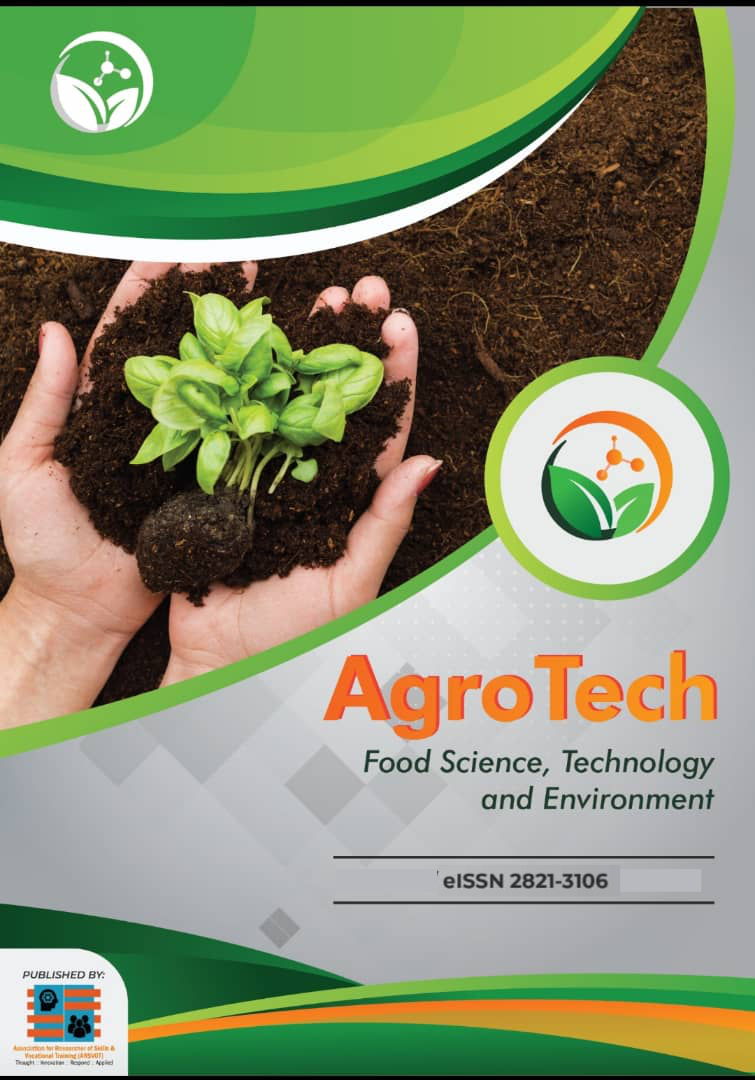Responses of Postharvest Quality of Banana (Musa paradisiaca L. var. Ambon) to Different Concentrations of 1-Methylcyclopropene
DOI:
https://doi.org/10.53797/agrotech.v2i2.9.2023Keywords:
1-Methylcyclopropene (1-MCP), banana ripening, postharvest quality, ethylene inhibition, Musa paradisiacaAbstract
Banana (Musa paradisiaca L. var. Ambon) is a climacteric fruit known for its high perishability due to rapid ripening mediated by ethylene. Postharvest losses significantly impact marketability, particularly during long-distance transport. 1-Methylcyclopropene (1-MCP) is an ethylene action inhibitor that has shown promise in delaying ripening and extending shelf life in various horticultural crops. This study investigated the effects of different concentrations of 1-MCP (0, 0.2, 0.4, and 0.6 g) on the postharvest quality of banana fruits during a 9-day storage period. Key quality parameters evaluated included weight loss, soluble solids concentration (SSC), titratable acidity (TA), pH, and maturity index. Results showed that higher 1-MCP concentrations significantly delayed ripening, reduced weight loss, suppressed SSC and TA accumulation, and maintained lower maturity indices compared to untreated controls. Bananas treated with 0.6 g 1-MCP exhibited the most prolonged retention of quality attributes and slowest ripening progression. These findings support the application of 1-MCP as an effective postharvest treatment to extend the marketable life of bananas during storage and distribution.
Downloads
References
Ahmad, S. A. E. E., Chatha, Z. A., Nasir, M. A., Aziz, A., & Mohson, M. (2006). Effect of relative humidity on the ripening behaviour and quality of ethylene treated banana fruit. Journal of Agriculture & Social Sciences, 1(2), 54–57.
Blankenship, S. M., & Dole, J. M. (2003). 1-Methylcyclopropene: A review. Postharvest Biology and Technology, 28(1), 1–25. https://doi.org/10.1016/S0925-5214(02)00246-6
Fan, X., Blankenship, S. M., & Mattheis, J. P. (1999). 1-Methylcyclopropene inhibits apple ripening. Journal of the American Society for Horticultural Science, 124(6), 690–695. https://doi.org/10.21273/JASHS.124.6.690
Guillon, F., Philippe, S., Bouchet, B., Devaux, M.-F., Frasse, P., Jones, B., Bouzayen, M., & Lahaye, M. (2008). Down-regulation of an auxin response factor in the tomato induces modification of fine pectin structure and tissue architecture. Journal of Experimental Botany, 59(10), 273–288. https://doi.org/10.1093/jxb/erm312
Harris, D. R., Seberry, J. A., Wills, R. B. H., & Spohr, L. J. (2000). Effect of fruit maturity on efficiency of 1-methylcyclopropene to delay the ripening of bananas. Postharvest Biology and Technology, 20(3), 303–308. https://doi.org/10.1016/S0925-5214(00)00135-1
Hofman, P. J., Jobin-Decor, M., Meiburg, G. F., Macnish, A. J., & Joyce, D. C. (2001). Ripening and quality responses of avocado, custard apple, mango and papaya fruit to 1-methylcyclopropene. Australian Journal of Experimental Agriculture, 41(4), 567–572. https://doi.org/10.1071/EA00166
Huang, H., Jing, G., Guo, L., Zhang, D., Yang, B., Duan, X., & Jiang, Y. (2013). Effect of oxalic acid on ripening attributes of banana fruit during storage. Postharvest Biology and Technology, 84, 22–27. https://doi.org/10.1016/j.postharvbio.2013.03.011
Jiang, Y., & Joyce, D. C. (2002). 1-Methylcyclopropene treatment effects on intact and fresh-cut apple. Journal of Horticultural Science and Biotechnology, 77(1), 19–21. https://doi.org/10.1080/14620316.2002.11511402
Jimenez, A., Creissen, G., Kular, B., Firmin, J., Robinson, S., Verhoeyen, M., & Mullineaux, P. (2002). Changes in oxidative processes and components of the antioxidant system during tomato fruit ripening. Planta, 214(5), 751–758. https://doi.org/10.1007/s00425-002-0764-5
Kader, A. A. (2002). Postharvest technology of horticultural crops (3rd ed.). UCANR Publications.
Mahajan, B. V. C., Singh, G., & Dhatt, A. S. (2008). Studies on ripening behaviour and quality of winter guava with ethylene gas and ethephon treatments. Journal of Food Science and Technology, 45(1), 81–84.
Marriott, J., Robinson, M., & Karikari, S. K. (2006). Starch and sugar transformation during the ripening of plantains and bananas. Journal of the Science of Food and Agriculture, 32(10), 1021–1026. https://doi.org/10.1002/jsfa.2740321015
Moing, A., Renaud, C., Gaudillère, M., Raymond, P., Roudeillac, P., & Denoyes-Rothan, B. (2001). Biochemical changes during fruit development of four strawberry cultivars. Journal of the American Society for Horticultural Science, 126(4), 394–403.
Nelson, S. C., Ploetz, R. C., & Kepler, A. K. (2006). Musa species (bananas and plantains). In C. R. Elevitch (Ed.), Species profiles for Pacific island agroforestry. Permanent Agriculture Resources. https://www.agroforestry.org/images/pdfs/Musa_banana_plantain.pdf
Sisler, E. C., & Serek, M. (2006). Inhibitors of ethylene responses in plants at the receptor level: Recent developments. Postharvest Biology and Technology, 41(1), 1–8. https://doi.org/10.1016/j.postharvbio.2005.10.004
Soltani, M., Alimardani, R., Omid, M., & Rajabipour, A. (2010). Changes in aroma volatile compounds of banana fruit during ripening. Australian Journal of Crop Science, 4(6), 453–458.
Tacken, E. J., Ireland, H. S., Gunaseelan, K., Karunairetnam, S., Wang, D., Schultz, K., ... & Johnston, J. W. (2010). The role of ethylene and other hormones in the regulation of fruit softening. Plant Physiology, 153(3), 1559–1570. https://doi.org/10.1104/pp.109.149286
Thammawong, M., & Arakawa, O. (2010). Starch degradation and enzyme activities during banana ripening. Postharvest Biology and Technology, 57(1), 38–45. https://doi.org/10.1016/j.postharvbio.2009.09.010
Wills, R. B. H., McGlasson, W. B., Graham, D., Joyce, D. C., & Horticultural Research and Development Corporation. (2007). Postharvest: An introduction to the physiology and handling of fruit, vegetables and ornamentals (5th ed.). UNSW Press.
Downloads
Published
How to Cite
Issue
Section
License
Copyright (c) 2023 arsvot

This work is licensed under a Creative Commons Attribution-NonCommercial-ShareAlike 4.0 International License.



